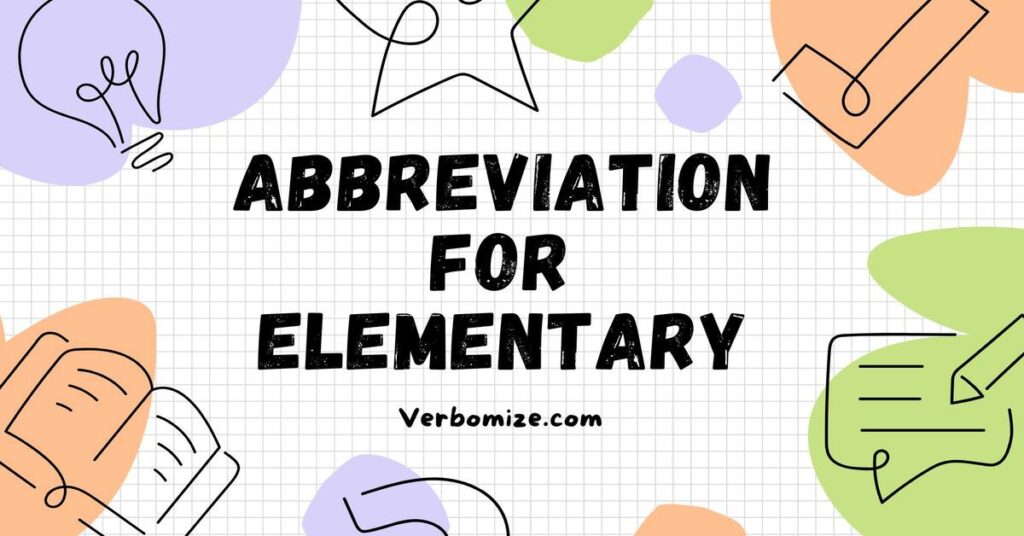The abbreviation for Elementary is something you’ve probably encountered but may not fully understand. Whether you’re a student, teacher, or just someone curious about education lingo, this simple elementary abbreviation holds more value than you might think. It’s everywhere – from school forms to curriculum guides – and knowing its meaning can save you time and confusion.
In this article, we’ll break down the abbreviation and explore why it’s important for you to know. You’ll learn how this small term plays a bigger role in education and how it can make navigating academic terms easier. Ready to uncover more? Keep reading!
What is the Common Abbreviation for “Elementary”?
When it comes to abbreviating the word elementary, the most common shortened form is “elem.”. This elementary abbreviation is widely recognized in both formal and informal contexts, particularly in educational settings.
For instance, you might see “elem.” on a school schedule, in textbooks, or when referring to basic-level classes like elem. science or elem. math.
Alternative Abbreviations:
- E.L.E.M.: Sometimes used, though less common, in more formal educational contexts.
- El.: Occasionally seen in shorthand but not as widely accepted as “elem.” or “E.L.E.M.”
These abbreviations are primarily used for efficiency and ease of reference, especially in documents and class schedules where space is limited.
The History Behind the Word “Elementary” and Its Abbreviation
The word “elementary” has its roots in the Latin word elementarius, meaning “pertaining to the elements” or “fundamental.” Over time, this term evolved in English to represent something basic or introductory.
Historically, elementary referred to the fundamental principles or building blocks of knowledge. In the context of education, it refers to the first stages of learning, such as elementary school, where children are taught foundational subjects like reading, writing, and arithmetic.
The abbreviation “elem.” first appeared as a practical shorthand in educational contexts where brevity was needed, particularly in schedules and notes. This abbreviation allowed teachers, administrators, and students to save time and space when discussing elementary subjects or classes.
Understanding “Elementary”: Meaning, Pronunciation, and Usage
Meaning
In its simplest form, “elementary” refers to the basics or the foundational level of a subject or concept. In the educational context, it refers to early education, typically from kindergarten through the fifth or sixth grade. It encompasses core subjects such as mathematics, reading, science, and social studies, all taught at an introductory level. The elementary school short form “ES” is commonly used in educational documents and communications for convenience and efficiency.
Pronunciation
The pronunciation of “elementary” can sometimes cause confusion due to regional differences. The standard phonetic pronunciation is:
/ˌɛlɪˈmɛntəri/
- eh-lih-men-tuh-ree
For the abbreviation “elem.”, the pronunciation is simplified to just “el-em” with the focus on the first syllable.
Usage
- Full form: The elementary school teaches the basics of math, science, and reading.
- Abbreviated form: I teach elem. science and math.
Why Abbreviate “Elementary”? The Practical Uses
To abbreviate elementary the use of abbreviations like “elem.” for elementary serves a variety of practical purposes. Here are a few key reasons why educators, students, and even parents might opt for the shortened form:
- Efficiency: In documents, schedules, and even communication, abbreviations save time and space.
- Clarity in School Documents: In official school records or curriculum outlines, space may be limited. Using “elem.” ensures brevity while retaining clarity.
- Ease of Communication: Particularly in educational settings, teachers, students, and administrators use abbreviations for quick reference, such as in class schedules, notes, and forms.
When and Where to Use “Elem.”: Contextual Considerations
Common Situations for Using “Elem.”
- Class Schedules: You might see “elem.” on timetables, especially in subjects like “elem. English” or “elem. math.”
- Course Catalogs: In course descriptions, “elem.” helps to identify the subject matter is related to early education.
- Reports and Documents: In school reports or district memos, “elem.” is used to save space while clearly communicating which grade level or subject is being discussed.
Professional vs. Casual Usage
While “elem.” is widely understood, it’s essential to be mindful of context:
- Professional Settings: In formal educational documents, it’s common to use the full form “elementary” rather than abbreviating.
- Casual or Informal Communication: In notes, emails, or conversations, “elem.” is perfectly acceptable, particularly when communicating with others who are familiar with educational terminology.
Is “Elem.” the Only Short Form for Elementary?
While “elem.” is the most common abbreviation for elementary, there are other variations, though less frequently used:
- El.: This shorter form is seen in some informal contexts but is less standardized and could cause confusion. It is not universally accepted in educational circles.
- E.L.E.M.: This more formal abbreviation might be seen in official documents or professional contexts, such as school district materials or formal curriculum outlines.
Acronyms vs. Abbreviations: Is There a Difference?
It’s important to clarify the difference between acronyms and abbreviations:
- Abbreviation: A shortened form of a word or phrase, typically omitting some letters (e.g., “elem.” for elementary).
- Acronym: A type of abbreviation formed by the first letters of a phrase (e.g., “NASA” for National Aeronautics and Space Administration).
Since “elem.” is a shortened form of “elementary” rather than a series of initials, it is technically an abbreviation, not an acronym.
The Correct Way to Pronounce “Elementary” and Its Abbreviation
When speaking, proper pronunciation ensures that your communication remains clear:
- Elementary: As mentioned earlier, the standard pronunciation is /ˌɛlɪˈmɛntəri/ (eh-lih-men-tuh-ree).
- Elem.: Simply pronounced as “el-em”.
Avoid mispronunciations such as “elementree” or “elemery” when using the full form.
When NOT to Use the Abbreviation “Elem.”
While abbreviations are practical, there are times when it’s best to avoid them:
- Formal Writing: In formal reports, academic papers, and official documents, it’s better to spell out “elementary” to maintain professionalism.
- New Audiences: If the audience is unfamiliar with educational terminology, it’s more appropriate to use the full word to avoid confusion.
- Legal Documents: For clarity and formality, legal documents related to education (e.g., school contracts or legal agreements) typically avoid abbreviations.
Real-World Example Sentences Using “Elementary” and “Elem.”
Here are some examples of how “elementary” and “elem.” might be used in sentences:
Full Form:
- “She is a teacher at the elementary school.”
- “The elementary curriculum covers subjects such as reading, science, and mathematics.”
Abbreviated Form:
- “The school offers elem. math and elem. science programs.”
- “I’m studying for my elem. education certification.”
These examples show how both forms are used naturally in different contexts.
Synonyms for “Elementary” and How They Compare
Several synonyms can replace “elementary” depending on the context:
- Basic: Often used when describing simple concepts or foundational knowledge.
- Introductory: Used for beginner-level content, often seen in course descriptions.
- Fundamental: Refers to essential principles or elements of a subject.
Comparison:
| Word | Usage Example | Context |
|---|---|---|
| Basic | “This is a basic overview of chemistry.” | Simplified explanation or concept |
| Introductory | “She’s enrolled in an introductory course in biology.” | Beginner-level material |
| Fundamental | “Fundamental math skills are taught in elementary school.” | Core principles or essential knowledge |
Antonyms for “Elementary” and Their Usage
The antonyms of “elementary” are often used when discussing advanced or more complex concepts:
- Advanced: Refers to higher-level, more complex topics.
- Complex: Denotes something that is not simple or easy to understand.
- Sophisticated: Used to describe more intricate or developed knowledge.
These words represent the opposite of basic education and are used to describe higher education, specialized skills, and advanced studies.
The Role of Abbreviations in Modern Language: A Reflection on Convenience
Language adapts to fulfill the needs of its speakers. Abbreviations like “elem.” are an example of how language adapts for convenience. In fast-paced environments like schools, efficiency is key, and abbreviations help save time and space. However, it’s important to use them judiciously, balancing convenience with clarity.
Wrapping Up: The Value of Abbreviating “Elementary”
In summary, the abbreviation for “elementary” (elem.) plays a significant role in modern education. It allows for efficiency, clarity, and brevity in a variety of contexts, from school schedules to informal communication. However, it’s essential to know when not to use it, particularly in formal settings where the full term is preferred for clarity and professionalism.
Understanding how and when to use “elem.” ensures effective communication in educational settings and beyond. By using abbreviations appropriately, we can streamline communication without losing the essence of what we are trying to convey.

Jone Smith is an experienced blogger and content creator behind Verbo Mize. With a passion for storytelling and insightful commentary, Jone brings a wealth of knowledge on diverse topics. His expertise in blogging, combined with a keen eye for detail, makes his work both informative and engaging, offering readers valuable perspectives on a wide range of subjects.







